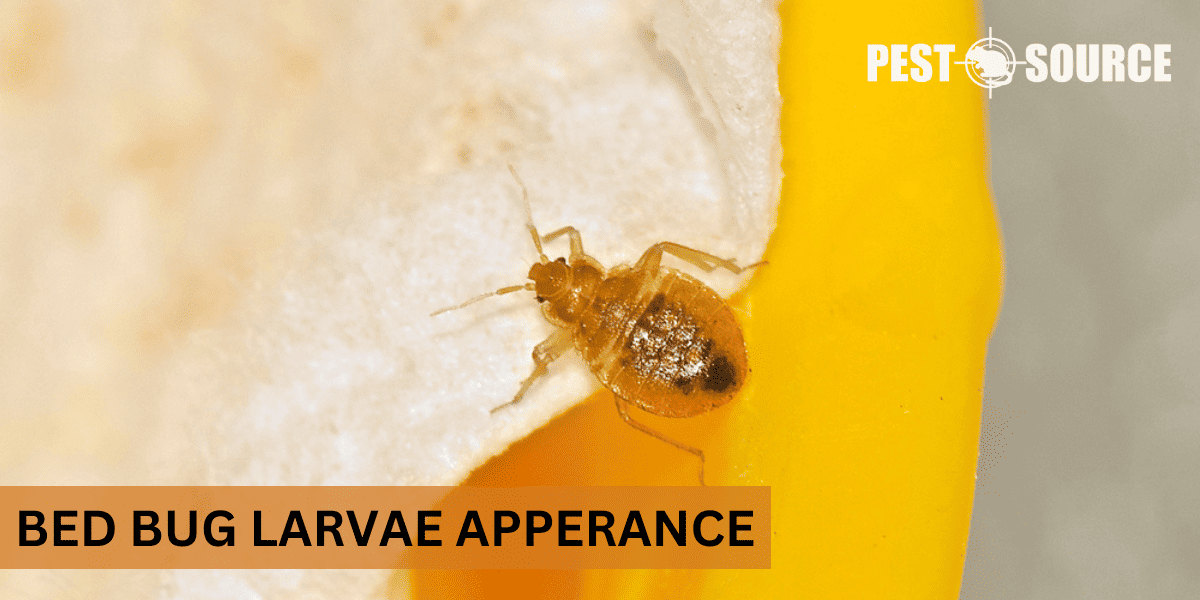Bed bug larvae, often referred to as nymphs, are smaller versions of adult bed bugs, starting out nearly colorless and becoming browner as they mature and feed. They are tiny, about 1.5 mm when they first hatch, and have a somewhat elongated shape. In the content ahead, you’ll find detailed descriptions and images to help identify bed bug nymphs at different stages.
POINTS
- Bed bugs don’t have a traditional larvae stage. Instead, they go from egg to nymph to adult. These nymphs, often referred to as ‘bed bug larvae,’ require frequent blood meals and have a high survival rate, making their control and prevention challenging.
- Early identification of bed bug infestations is key to effective control. Recognizing the distinct physical characteristics of bed bug nymphs (such as their small, flat body, light/whitish-yellow color, and tendencies to become brighter red after a blood meal) can aid in this.
- Bed bug eggs are tiny, oval, and off-white, looking similar to a grain of salt or sugar. Females lay their eggs in secluded, dark areas close to a food source. These eggs, while hard to spot, provide vital clues to an infestation.
- Understanding the preferred habitats and behaviors of both nymphs and eggs contribute to effective extermination strategies. For instance, knowing that nymphs are attracted to human breathing can illuminate their likely hiding spots.
- Many misconceptions surround bed bugs, leading to misidentification and misapplication of treatment techniques. Ensuring an understanding of the differences between bed bug nymphs and other bugs (like maggots), and the appearance of bed bug eggs versus grains of salt or other bug eggs, can help avoid these pitfalls.
What is the Basic Biology of Bed Bugs?
Do bed bugs have larvae?
Contrary to popular belief, bed bugs don’t have a larval stage. Bed bugs have a simple life cycle: from egg to nymph to adult. Nymphs are often referred to as ‘bed bug larvae’ due to their small size and light color. However, unlike most insects, bed bugs do not undergo complete metamorphosis with distinct egg, larval, pupal, and adult stages.
How do bed bugs reproduce?
Bed bugs reproduce through a process called traumatic insemination. After mating, females lay a few eggs each day until she has laid hundreds of eggs. These eggs are about the size of a speck of dust and are laid in secluded spaces where they are protected from external aggression.
What is the importance of the ‘larval stage’ in a bed bug’s life?
The ‘larval stage,’ or more appropriately called nymph or juvenile stage, is highly critical from the bed bug’s perspective. During this phase, they have to gain enough nutrients for their growth and development into adulthood. They achieve this by feeding more often. Also, encapsulated within the nymph stage, is the ability to withstand harsh environments, making their ability to infest areas more potent. Understanding this stage gives us a clear insight into their survival mechanisms and can aid in their control and prevention.
What Do Bed Bug ‘Larvae’ Look Like?
Before we dive in, remember that when we say ‘larvae,’ we’re actually referring to bed bug nymphs, or baby bed bugs. These nymphs are essentially miniature versions of adult bed bugs, but lighter in color and smaller in size.
What are the physical characteristics of bed bug nymphs?
Bed bug nymphs, oftentimes referred to as larvae, are approximately 1.5mm long and are usually translucent or whitish-yellow in color. They display a flattened body similar to that of adult bugs, and are equipped with six legs and a pair of antennae.
What color are bed bug nymphs?
As touched on earlier, newly hatched nymphs can be quite pale, nearly translucent or whitish-yellow. However, after a blood meal, these nymphs often appear bright red due to the blood visible inside their small bodies.
What is the size of bed bug nymphs?
When they hatch, nymphs are approximately the size of a grain of rice, nearly 1.5mm in length. However, as they progress through their molting stages, they progressively increase in size, reaching a length of approximately 4.5mm when fully grown.
How do bed bug nymphs differ in appearance from adult bed bugs?
In size and color, nymphs starkly differ from their adult counterparts. While adults are brown and about the size of an apple seed, nymphs are smaller and tend to be more transparent, especially before their first feeding. After a blood meal, these nymphs take on a reddish color. Aside from size and color, both nymphs and adults possess a similar shape—oval and flattened from top to bottom.
Behavior of Bed Bug Nymphs
Just like adult bed bugs, nymphs are also primarily nocturnal creatures. They’re incredibly active at night when humans sleep. Understanding their behavior can provide crucial information on their habits and help us devise effective control and prevention plans.
How do bed bug nymphs move?
Despite their tiny size, bed bug nymphs are quite nimble. They can crawl several feet to obtain a blood meal. They move rather quickly for their size and can easily travel across ceilings, walls, and floors.
How often do bed bug nymphs feed?
Bed bug nymphs feed more often than adults. They require a blood meal for each of their five molting stages before reaching adulthood. So, if conditions are favorable and food is readily available, they could potentially try to feed every day. It’s worth noting that an individual nymph’s feeding frequency can significantly impact their development time.
What are some typical behaviors of bed bug nymphs?
One well-studied behavior of bed bug nymphs is their innate attraction to human breathing. They can sense and are drawn to the carbon dioxide we exhale, which is one reason why they often infest sleeping areas. Other typical behaviors include hiding in narrow or tight spaces where the adult bugs reside for safety and proximity to a food source. They also tend to congregate in groups, adhering to a ‘safety-in-numbers’ approach. Finally, once they have had their fill of a blood meal, they scurry back to their secluded hiding spots. Understanding these behaviors can greatly assist in the early identification and effective eradication of an infestation.
What Do Bed Bug Eggs Look Like?
Bed bug eggs are a vital part of their lifecycle. Recognizing them can help you identify a potential infestation early and take immediate action.
What are the physical characteristics of bed bug eggs?
Bed bug eggs are tiny, about 1 millimeter in size, making them difficult to spot with the naked eye. They have a pearlescent, off-white color, and are shaped like a grain of rice. The eggs may also appear slightly opalescent due to the sticky “glue” the female bed bug uses to attach them to surfaces.
Where do bed bugs lay eggs?
Bed bugs prefer laying eggs in dark, secluded areas. These include behind baseboards, in the seams of mattresses, in the cracks of furniture, or along the edges of carpets. Essentially, they will lay eggs wherever they can find a hidden place close to a potential food source.
What do bed bug eggs look like?
The oval-shaped bed bug eggs are difficult to spot due to their tiny size and color. They have a distinctive elongated, cylindrical shape with one end rounded and the other more pointed. They are similar in size to a single granule of sugar or salt.
How do bed bug eggs differ from bed bug nymphs?
Bed bug eggs can be differentiated from nymphs based on size, color, and form. While nymphs are somewhat larger and tend to be translucent or whitish-yellow, eggs are much smaller, rounder, and exhibit a more whitish color.
What does a bed bug egg sac look like?
Bed bugs don’t create egg sacs. Instead, female bed bugs lay individual eggs that they secure to surfaces with a clear, sticky substance.
Are bed bug eggs hard, and what do they feel like?
Bed bug eggs have a certain degree of hardness to protect the developing bed bugs inside. Not as hard as, say, a bird’s egg, they could be compared to the hardness of a thick plastic sheet. If you were to touch them, they’d feel somewhat similar to a grain of uncooked rice.
How Many Eggs Do Bed Bugs Lay Daily?
Once mated, bed bugs are capable of laying a surprising number of eggs, especially considering their tiny size.
How many eggs does a bed bug lay per day?
A female bed bug lays, on average, one to five eggs per day. Over her lifespan, a female can lay anywhere from 200 to 500 eggs, contingent upon her access to a steady food source and favorable environmental conditions.
Is there any variation in egg-laying frequency among bed bugs?
Yes, the egg-laying frequency among bed bugs can indeed vary. Several factors may trigger these variations, such as the availability of food, environmental conditions, and the health and age of the female bed bug. For instance, younger, healthier bed bugs tend to lay more eggs, whereas older or malnourished bugs may lay fewer. Bed bugs’ reproductive habits are, in many ways, like those of other insects, with the potential to rapidly explode in population under the right circumstances.
What Is the Life Cycle of Bed Bug Eggs?
Understanding the life cycle of bed bug eggs can provide important clues to help manage an infestation effectively.
How long does it take for bed bug eggs to hatch?
Typically, bed bug eggs hatch within 6 to 10 days, dependent on the temperature and humidity of their environment. Warmer environments tend to accelerate their hatching process.
What conditions influence the hatching time of bed bug eggs?
Environmental conditions significantly impact the hatching time of bed bug eggs. Factors such as temperature and humidity play major roles. The optimal temperature for bed bug egg hatching is around 80°F (27°C). Meanwhile, they require a relatively high level of humidity—approximately 75%—to prevent desiccation.
What happens when bed bugs eggs hatch, and what do the hatching nymphs look like?
Once bed bug eggs hatch, they unleash the nymphs—often referred to as the ‘larval stage’ of bed bugs—into their surroundings. These newly hatched nymphs are tiny, translucent or whitish-yellow creatures approximately 1.5mm in size. Highly motivated to feed, they diligently seek out hosts for their crucial first blood meal, which they need before they can begin their molt into the next stage of their life cycle.
How to Differentiate Between Bed Bug Eggs, Nymphs, and Other Similar Bugs?
Correctly identifying bed bug eggs and nymphs is instrumental in dealing with an infestation. Misidentifying them makes successful treatment and prevention challenging.
How can you differentiate bed bug nymphs from other bug nymphs?
Bed bug nymphs have distinct characteristics that set them apart from other bug nymphs. They are tiny and translucent or whitish-yellow, the size of a grain of rice with an oval, flattened body. After a feed, they turn a brighter red color.
These features distinguish them from spider mites or booklice that are also small but vary in shape, color, and other physical traits. For instance, spider mites are round and reddish-brown or pale in color, while booklice are elongated and brownish or yellow.
How can you differentiate bed bug eggs from other bug eggs or common household substances (like salt)?
While bed bug eggs resemble a single grain of salt or sugar, they have a unique elongated, cylindrical shape with one rounded end and one pointed end. On close examination, their color differences also become evident. They have a distinctive pearlescent glow compared to the matt white of salt.
Compared to other bug eggs, bed bug eggs are typically very small and are sticky to the touch due to the adhesive used by the female to attach them to surfaces.
Are there any notable comparisons between bed bug eggs and nymphs and other insects, such as maggots?
Though at a passing glance, someone might confuse bed bug nymphs and maggots due to their small size and pale color, significant differences exist.
Bed bug nymphs are more elongated, possess six legs, and are generally static except when seeking a blood meal. In contrast, maggots (which are fly larvae) have a more cylindrical, segmented appearance, are legless, and are usually found around decaying organic matter.
Misconceptions and Myths About Bed Bugs
Misinformation about bed bugs can unfortunately result in ineffective control tactics or even unnecessary panic. Let’s debunk some common myths that surround these tiny pests.
Why are bed bug nymphs sometimes mistaken for maggots?
Due to their small size and light color, it’s not uncommon for bed bug nymphs to be mistaken for maggots. As explained earlier, there are notable differences in shape, movement, and habitat between the two, making it easy to distinguish them upon closer inspection.
Do bed bug eggs look like salt, and why is this a common misconception?
Bed bug eggs can superficially resemble tiny grains of salt or sugar due to their size and color, leading to possible misidentification. However, they differ greatly in texture, hardness, and shape. Upon close inspection, the differences become apparent.



